综合案例TermListTheHundredYears'War百年战争(即是指英国和
- 格式:doc
- 大小:102.00 KB
- 文档页数:7

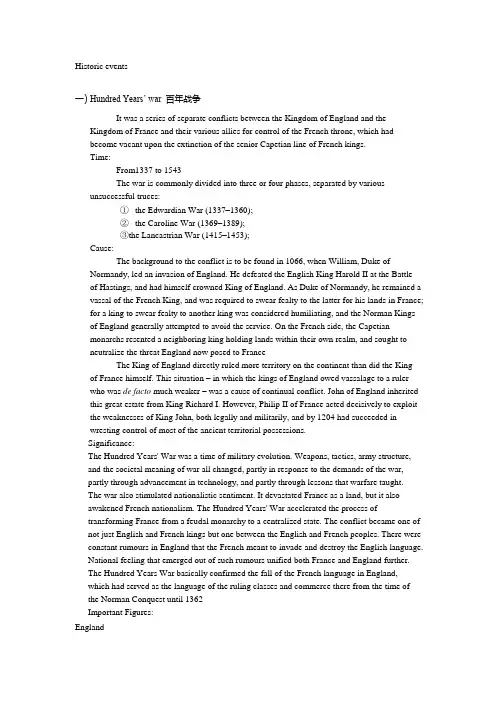
Historic events一)Hundred Years’ war 百年战争It was a series of separate conflicts between the Kingdom of England and the Kingdom of France and their various allies for control of the French throne, which hadbecome vacant upon the extinction of the senior Capetian line of French kings.Time:From1337 to 1543The war is commonly divided into three or four phases, separated by various unsuccessful truces:①the Edwardian War (1337–1360);②the Caroline War (1369–1389);③the Lancastrian War (1415–1453);Cause:The background to the conflict is to be found in 1066, when William, Duke of Normandy, led an invasion of England. He defeated the English King Harold II at the Battle of Hastings, and had himself crowned King of England. As Duke of Normandy, he remained a vassal of the French King, and was required to swear fealty to the latter for his lands in France;for a king to swear fealty to another king was considered humiliating, and the Norman Kings of England generally attempted to avoid the service. On the French side, the Capetianmonarchs resented a neighboring king holding lands within their own realm, and sought to neutralize the threat England now posed to FranceThe King of England directly ruled more territory on the continent than did the King of France himself. This situation – in which the kings of England owed vassalage to a ruler who was de facto much weaker – was a cause of continual conflict. John of England inherited this great estate from King Richard I. However, Philip II of France acted decisively to exploit the weaknesses of King John, both legally and militarily, and by 1204 had succeeded inwresting control of most of the ancient territorial possessions.Significance:The Hundred Years' War was a time of military evolution. Weapons, tactics, army structure, and the societal meaning of war all changed, partly in response to the demands of the war, partly through advancement in technology, and partly through lessons that warfare taught.The war also stimulated nationalistic sentiment. It devastated France as a land, but it alsoawakened French nationalism. The Hundred Years' War accelerated the process oftransforming France from a feudal monarchy to a centralized state. The conflict became one of not just English and French kings but one between the English and French peoples. There were constant rumours in England that the French meant to invade and destroy the English language.National feeling that emerged out of such rumours unified both France and England further.The Hundred Years War basically confirmed the fall of the French language in England,which had served as the language of the ruling classes and commerce there from the time of the Norman Conquest until 1362Important Figures:EnglandKing Edward III 1327–1377 Edward II's sonKing Richard II 1377–1399 Edward III's grandsonKing Henry IV 1399–1413 Edward III's grandsonKing Henry V 1413–1422 Henry IV's sonKing Henry VI 1422–1461 Henry V's sonEdward, the Black Prince 1330–1376 Edward III's sonJohn of Gaunt, 1st Duke of Lancaster 1340–1399 Edward III's sonJohn of Lancaster, 1st Duke of Bedford 1389–1435 Henry IV's sonHenry of Grosmont, 1st Duke of Lancaster 1306–1361 KnightJohn Talbot, 1st Earl of Shrewsbury 1384–1453 KnightRichard Plantagenet, 3rd Duke of York 1411–1460 KnightSir John Fastolf 1378?–1459 KnightFranceKing Philip VI 1328–1350King John II 1350–1364 Philip VI's sonKing Charles V 1364–1380 John II's sonLouis I of Anjou 1380–1382 John II's sonKing Charles VI 1380–1422 Charles V's sonKing Charles VII 1422–1461 Charles VI's sonJoan of Arc 1412–1431 CommanderJean de Dunois 1403–1468 KnightGilles de Rais 1404–1440 KnightBertrand du Guesclin 1320–1380 KnightJean Bureau 13??–1463 KnightLa Hire 1390–1443 Knight二)civil war (1642-1651)南北战争, 又称美国内战The American Civil War, often referred to simply as The Civil War in the United States, was a civil war fought in the United States of America.Time:From 1642 to 1651Cause:The causes of the Civil War were complex, and have been controversial since the war began. The issue has been further complicated by historical revisionists, who have tried to improve the image of the South by lessening the role of slavery.Slavery was the central source of escalating political tension in the 1850s. The Republican Party was determined to prevent any spread of slavery, and many Southernleaders had threatened secession if the Republican candidate, Lincoln, won the 1860 election.Following Lincoln's victory, many Southern whites felt that disunion had become their only option.While not all Southerners saw themselves as fighting to preserve slavery, most of the officers and over a third of the rank and file in Lee's army had close family ties to slavery. To Northerners, in contrast, the motivation was primarily to preserve the Union, not to abolish slavery.Abraham Lincoln consistently made preserving the Union the central goal of the war, though he increasingly saw slavery as a crucial issue and made ending it an additional goal. Lincoln's decision to issue the Emancipation Proclamation angered both Peace Democrats and War Democrats, but energized most Republicans.By warning that free blacks would flood the North, Democrats made gains in the 1862 elections, but they did not gain control of Congress. The Republicans' counterargument that slavery was the mainstay of the enemy steadily gained support, with the Democrats crushed at the 1863 elections in Ohio when they tried to resurrect anti-black sentiment.Main Content:*The beginning of the war, 1861Lincoln's victory in the presidential election of 1860 triggered South Carolina's declaration of secession from the Union.On February 7 1861, the seven states adopted a provisional constitution for the Confederate States of America and established their temporary capital at Montgomery, Alabama.A pre-war February Peace Conference of 1861 met in Washington in a failed attempt at resolving the crisis. However, governors in Massachusetts, New York, and Pennsylvania quietly began buying weapons and training militia units. The great meeting in Union Square, New York, to support the government, April 20, 1861On May 3, 1861, Lincoln called for an additional 42,034 volunteers for a period of three yearsFour states in the upper South (Tennessee, Arkansas, North Carolina, and Virginia), which had repeatedly rejected Confederate overtures, now refused to send forces against their neighbors, declared their secession, and joined the Confederacy. To reward Virginia, the Confederate capital was moved to Richmond which was the symbol of the Confederacy.*Anaconda Plan and blockade, 1861Winfield Scott, the commanding general of the U.S. Army, devised the Anaconda Plan to win the war with as little bloodshed as possible.His idea was that a Union blockade of the main ports would weaken the Confederate economy; then the capture of the Mississippi River would split the South. Lincoln adopted the plan in terms of a blockade to squeeze to death the Confederate economy, but overruled Scott's warnings that his new army was not ready for an offensive operation because public opinion demanded an immediate attackIn April 1861, Lincoln announced the Union blockade of all Southern ports; commercial ships could not get insurance and regular traffic ended.On March 8, 1862, the Confederate Navy waged a fight against the Union Navy when the ironclad CSS Virginia attacked the blockade.Northern technology achieved another breakthrough on April 10–11, 1862.Eastern theater 1861–1863Western theater 1861–1863Trans-Mississippi theater 1861–1865Conquest of Virginia and end of war: 1864–1865On June 23, 1865, Cherokee leader Stand Watie was the last Confederate general to surrender his forces, which it is the end of the war.战争期间主要战役战役时间胜方盖兹堡之役1863年7月1日–3日联邦奇卡莫加之役1863年9月19日–20日邦联第一次牛奔河之役1861年7月21日–4日邦联第二次牛奔河之役1862年8月29日–2日邦联钱瑟勒斯维尔之役1863年5月1日–4日邦联斯波瑟韦尼亚郡府之役1864年5月8日–19日不明安地潭之役1862年9月17日联邦莽原之役1864年5月5日–7日不明马那萨斯之战1862年8月29日–30日邦联石河之役1862年12月31日联邦唐奈尔森堡之役1862年2月13日–16日联邦塞罗之役1862年4月6日–7日联邦汉普顿锚地海战1862年3月8日–3月9日邦联三)Glorious Revolution (1688-89)光荣革命The Glorious Revolution, also called the Revolution of 1688, is the name of the overthrow of King James II of England by a union of English Parliamentarians with the Dutch stadtholder William III of Orange-Nassau.Time:From1688 – 1689Cause:英国封建斯图亚特王朝国王查理一世统治时期,资本主义迅速发展。

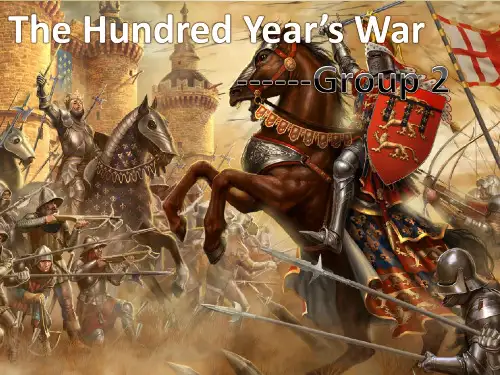
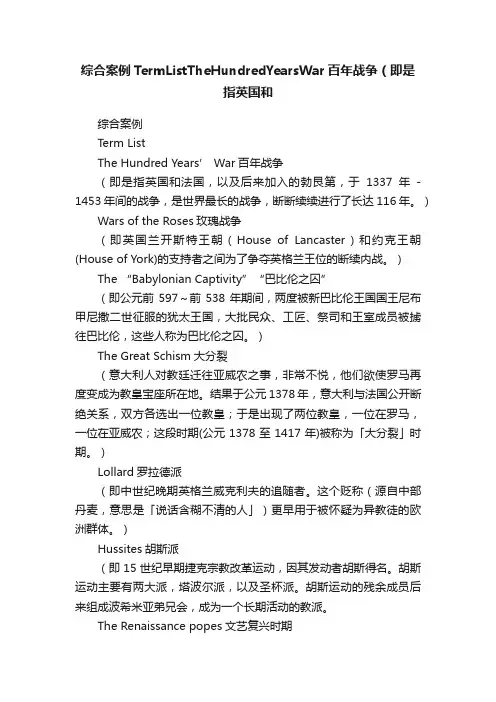
综合案例TermListTheHundredYearsWar百年战争(即是指英国和综合案例Term ListThe Hundred Years’ War百年战争(即是指英国和法国,以及后来加入的勃艮第,于1337年- 1453年间的战争,是世界最长的战争,断断续续进行了长达116年。
)Wars of the Roses玫瑰战争(即英国兰开斯特王朝(House of Lancaster)和约克王朝(House of York)的支持者之间为了争夺英格兰王位的断续内战。
)The “Babylonian Captivity”“巴比伦之囚”(即公元前597~前538年期间,两度被新巴比伦王国国王尼布甲尼撒二世征服的犹太王国,大批民众、工匠、祭司和王室成员被掳往巴比伦,这些人称为巴比伦之囚。
)The Great Schism大分裂(意大利人对教廷迁往亚威农之事,非常不悦,他们欲使罗马再度变成为教皇宝座所在地。
结果于公元1378年,意大利与法国公开断绝关系,双方各选出一位教皇;于是出现了两位教皇,一位在罗马,一位在亚威农;这段时期(公元1378至1417年)被称为「大分裂」时期。
)Lollard罗拉德派(即中世纪晚期英格兰威克利夫的追随者。
这个贬称(源自中部丹麦,意思是「说话含糊不清的人」)更早用于被怀疑为异教徒的欧洲群体。
)Hussites胡斯派(即15世纪早期捷克宗教改革运动,因其发动者胡斯得名。
胡斯运动主要有两大派,塔波尔派,以及圣杯派。
胡斯运动的残余成员后来组成波希米亚弟兄会,成为一个长期活动的教派。
The Renaissance popes文艺复兴时期(文艺复兴是指13世纪末在意大利各城市兴起,以后扩展到西欧各国,于16世纪在欧洲盛行的一场思想文化运动,带来一段科学与艺术革命时期,揭开了近代欧洲历史的序幕,被认为是中古时代和近代的分界。
)Austria18世纪初,哈布斯堡王朝领土空前扩大。
1815年维也纳会议后成立了以奥为首的德意志邦联,1866年在普奥战争中失败,邦联解散。
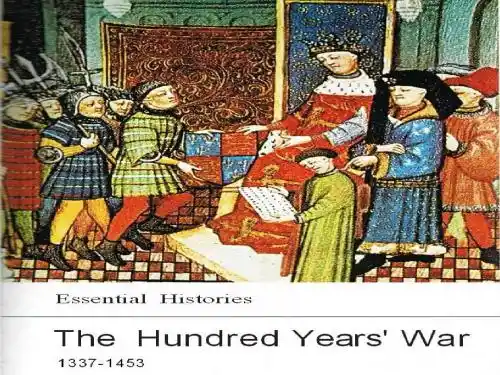
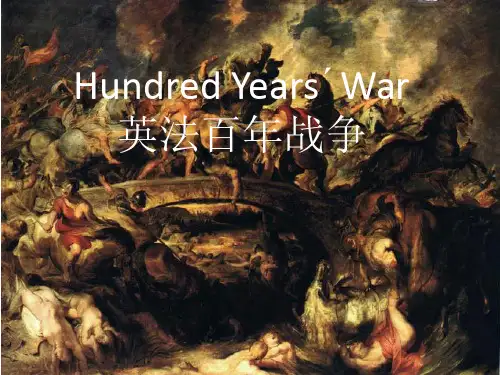
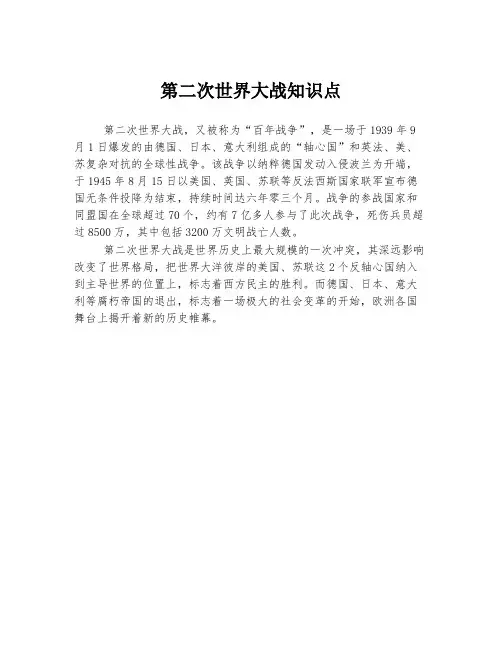
第二次世界大战知识点
第二次世界大战,又被称为“百年战争”,是一场于1939年9月1日爆发的由德国、日本、意大利组成的“轴心国”和英法、美、苏复杂对抗的全球性战争。
该战争以纳粹德国发动入侵波兰为开端,于1945年8月15日以美国、英国、苏联等反法西斯国家联军宣布德国无条件投降为结束,持续时间达六年零三个月。
战争的参战国家和同盟国在全球超过70个,约有7亿多人参与了此次战争,死伤兵员超过8500万,其中包括3200万文明战亡人数。
第二次世界大战是世界历史上最大规模的一次冲突,其深远影响改变了世界格局,把世界大洋彼岸的美国、苏联这2个反轴心国纳入到主导世界的位置上,标志着西方民主的胜利。
而德国、日本、意大利等腐朽帝国的退出,标志着一场极大的社会变革的开始,欧洲各国舞台上揭开着新的历史帷幕。
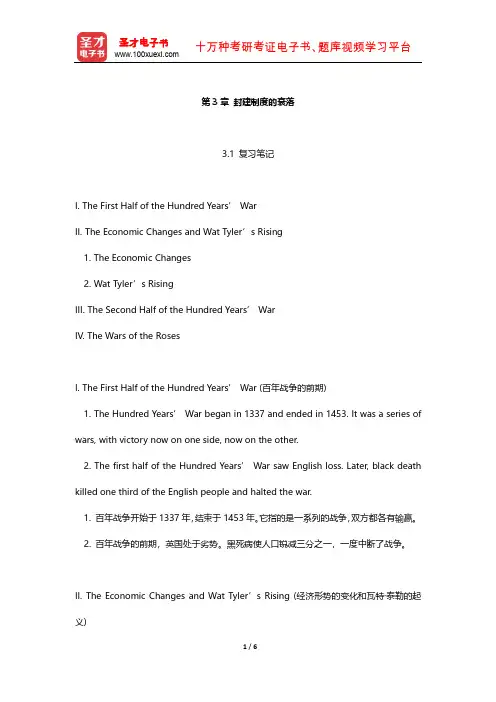
第3章封建制度的衰落3.1 复习笔记I. The First Half of the Hundred Years’ WarII. The Economic Changes and Wat Tyler’s Rising1. The Economic Changes2. Wat Tyler’s RisingIII. The Second Half of the Hundred Years’ WarIV. The Wars of the RosesI. The First Half of the Hundred Years’ War (百年战争的前期)1. T he Hundred Years’ War began in 1337 and ended in 1453. It was a series of wars, with victory now on one side, now on the other.2. T he first half of the Hundred Years’ War saw English loss. Later, black death killed one third of the English people and halted the war.1. 百年战争开始于1337年,结束于1453年。
它指的是一系列的战争,双方都各有输赢。
2. 百年战争的前期,英国处于劣势。
黑死病使人口锐减三分之一,一度中断了战争。
II. The Economic Changes and Wat Tyler’s Rising (经济形势的变化和瓦特·泰勒的起义)1. The Economic Changes (经济形势的变化)(1) Feudalism in England began to decline in the nearly 14th.(2) The vigorous economic progress of the 13th-century petered out early in the 14th century. A natural economy gradually gave way to a money economy.(3) The shortage of labor caused by the Black Death gave a chance for agricultural laborers in villages.(1) 14世纪早期,英国的封建制度开始衰落。
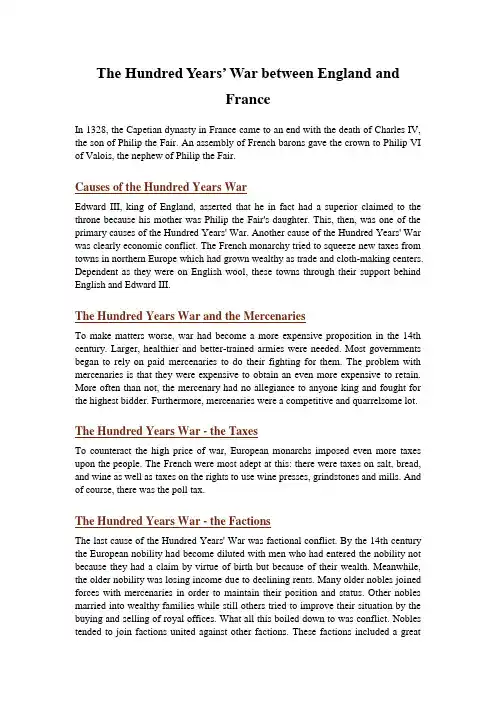
The Hundred Years’ War between England andFranceIn 1328, the Capetian dynasty in France came to an end with the death of Charles IV, the son of Philip the Fair. An assembly of French barons gave the crown to Philip VI of Valois, the nephew of Philip the Fair.Causes of the Hundred Years WarEdward III, king of England, asserted that he in fact had a superior claimed to the throne because his mother was Philip the Fair's daughter. This, then, was one of the primary causes of the Hundred Years' War. Another cause of the Hundred Years' War was clearly economic conflict. The French monarchy tried to squeeze new taxes from towns in northern Europe which had grown wealthy as trade and cloth-making centers. Dependent as they were on English wool, these towns through their support behind English and Edward III.The Hundred Years War and the MercenariesTo make matters worse, war had become a more expensive proposition in the 14th century. Larger, healthier and better-trained armies were needed. Most governments began to rely on paid mercenaries to do their fighting for them. The problem with mercenaries is that they were expensive to obtain an even more expensive to retain. More often than not, the mercenary had no allegiance to anyone king and fought for the highest bidder. Furthermore, mercenaries were a competitive and quarrelsome lot. The Hundred Years War - the TaxesTo counteract the high price of war, European monarchs imposed even more taxes upon the people. The French were most adept at this: there were taxes on salt, bread, and wine as well as taxes on the rights to use wine presses, grindstones and mills. And of course, there was the poll tax.The Hundred Years War - the FactionsThe last cause of the Hundred Years' War was factional conflict. By the 14th century the European nobility had become diluted with men who had entered the nobility not because they had a claim by virtue of birth but because of their wealth. Meanwhile, the older nobility was losing income due to declining rents. Many older nobles joined forces with mercenaries in order to maintain their position and status. Other nobles married into wealthy families while still others tried to improve their situation by the buying and selling of royal offices. What all this boiled down to was conflict. Nobles tended to join factions united against other factions. These factions included a greatfamily, their knights, servants and even workers and peasants on the manorial estate. They had their own small armies, loyalties and even symbols of allegiance. The bottom line is that these factions were beginning to form small states within a state and contributed not only to the overall violence of the 14th century but also to the need of monarchs to keep their nobility under constant surveillance. This explains why Louis XIV, the Sun King, housed his nobility at Versailles -- it was so he could keep an eye on them.The Hundred Years War - AquitaineThe most pressing issue during the Hundred Years' War was the status of Aquitaine, a large province in south western France. According to feudal law, Edward III held Aquitaine as part of his fiefdom. Philip attacked this territory, claiming it was rightfully his. Edward's response was to join forces with the Flemish in 1337 and this was the principal cause of the war.The Hundred Years WarThe war, fought entirely on French soil, raged off and on for more than 100 years. English victories were followed by French victories, then a period of stalemate would ensue, until the conflicts again rose to the surface. During periods of truce, English and French soldiers -- most of whom were mercenaries -- would roam the French countryside killing and stealing. After the battle of Agincourt in 1415, won by the English under Henry V, the English controlled most of northern France. It appeared that England would shortly conquer France and unite the two countries under one crown. At this crucial moment in French history, a young and illiterate peasant girl, Joan of Arc (c.1412-1431), helped to rescue France.The One Hundred Years War and Joan of ArcAt the age of 13 Joan believed she had heard the voices of St. Michael, St. Catherine and St. Margaret bidding her to rescue the French people. Believing that God had commanded her to drive the English out of France, Joan rallied the demoralized French troops, leading them in battle. Clad in a suit of white armor and flying her own standard she liberated France from the English at the battle of Orleans. Ultimately captured and imprisoned by the English, Joan of Arc was condemned as a heretic and a witch and stood trial before the Inquisition in 1431. Joan was found guilty and was to be burnt at the stake but at the last moment she broke down and recanted everything. She eventually broke down again and faithful to her "voices," decided to become a martyr and was then burnt at the stake and became a national hero.。
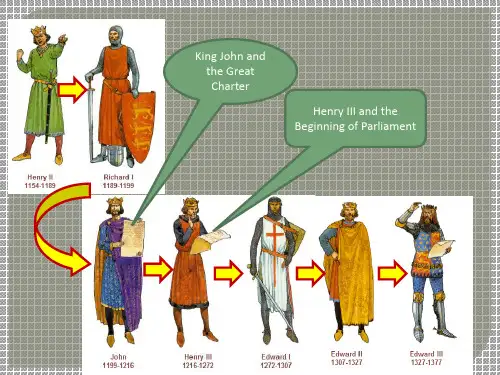
The Hundred Y ears WarThe Hundred Y ears War was a series of wars between England and France. The background of the Hundred Y ears War went as far back as to the reign of William the Conqueror. When William the Conqueror became king in 1066 after his victory at the Battle of Hastings, he united England with Normandy in France. William ruled both as his own.Under Henry II, the lands owned by England in France became even larger and the kings who followed Henry found the land they owned in France too large and difficult to control. By 1327, when Edward III became king, England only controlled two areas of France - Gascony in the south and Ponthieu in the north.In 1328, Charles IV of France died. Charles did not have any sons to take over his land and all his brothers were dead. He did have a sister called Isabella. She was the mother of Edward III and Edward believed that because of this, he should be king of France. However, the French decided that a cousin of Charles, Philip, should be crowned king.Edwar d was furious but he was not in a position to do anything in the late 1320’s. By 1337 he was ready to fight for what he believed was his and he declared war on Philip. Edward was not only willing to fight for what he believed was his - the crown of France - but also he feared that Philip was a threat to his possessions in France - Gascony and Ponthieu.Edward now had to raise an army. There were men who looked forward to fighting abroad in an army as it gave them the opportunity to plunder treasure and bring things back to England which could make them rich. However, many men were not keen on fighting as they were usually more concerned about farming. A war in the autumn could be a disaster as this was harvest time.The feudal system meant that knights had to provide the king with soldiers when the king demanded them. However, war had moved on from the time of the Battle of Hastings and the longbow was now the most feared of weapons and not the knight on horseback. The king's officials went around England looking for skilled archers. All young men in medieval villages were expected to practice archery so there were many skilled archers to be found. It was left to a village to decide who would actually go to fight but the village as a whole would have to look after the family or families affected by someone leaving. Those who went were paid three pence a day.Armies were very expensive. Fighting abroad made them even more expensive to run. This problem could be got around by making a local area in France, which was under your control, pay a 'tribune' to you. This would keep your costs down. In return for paying a tribune, the area concerned was given a promise that the troops there would behave themselves and would not damage homes, steal crops and kill animals. In this sense, paying a tribune was similar to buying protection.百年战争百年战争是一系列英国和法国之间的战争。
2016年翻译硕士考研指导MTI百科知识名词解释百年战争(Hundred Years'War)是指英国和法国,以及后来加入的勃艮第,于1337年-1453年间的战争,是世界最长的战争,断断续续进行了长达116年,百年战争中,发展出不少新战术和武器。
十字军东征(The Crusades)是在1096年到1291年发生的六次宗教性军事行动的总称,是由西欧基督教(天主教)国家对地中海东岸的国家发动的战争。
由于罗马天主教圣城耶路撒冷落入伊斯兰教徒手中,十字军东征大多数是针对伊斯兰教国家的,主要的目的是从伊斯兰教手中夺回耶路撒冷。
东征期间,教会授予每一个战士十字架,组成的军队称为十字军。
十字军东征一般被认为是天主教的暴行。
尽管如此,十字军东征使西欧直接接触到了当时更为先进的拜占庭文明和伊斯兰文明。
这种接触,为欧洲的文艺复兴开辟了道路。
《论语》是儒家学派的经典著作之一,由孔子的弟子及其再传弟子编撰而成。
它以语录体和对话文体为主,记录了孔子及其弟子言行,集中体现了孔子的政治主张、论理思想、道德观念及教育原则等。
与《大学》《中庸》《孟子》《诗经》《尚书》《礼记》《易经》《春秋》并称“四书五经”。
通行本《论语》共二十篇。
老子主要指我国古代伟大的哲学家和思想家、道家学派创始人老子,其被唐皇武后封为太上老君,世界文化名人,世界百位历史名人之一,存世有《道德经》(又称《老子》),其作品的精华是朴素的辨证法,主张无为而治,其学说对中国哲学发展具有深刻影响。
在道教中老子被尊为道祖。
佛教(Buddhism):世界三大宗教之一,由公元前6-前5世纪古印度的迦毗罗卫国(今尼泊尔境内)王子所创,他的名字是悉达多(S.Siddhārtha,P.Siddhattha),他的姓是乔达摩(S. Gautama,P.Gotama)。
因为他属于释迦(Sākya)族,人们又称他为释迦牟尼,意思是释迦族的圣人。
广泛流传于亚洲的许多国家。
东汉时自西向东传入我国。
The Hundred Years WarThe Hundred Years War was a series of wars between England and France. The background of the Hundred Years War went as far back as to the reign of William the Conqueror. When William the Conqueror became king in 1066 after his victory atthe Battle of Hastings, he united England with Normandy in France. William ruled both as his own.Under Henry II, the lands owned by England in France became even larger and the kings who followed Henry found the land they owned in France too large and difficult to control. By 1327, when Edward III became king, England only controlled two areas of France - Gascony in the south and Ponthieu in the north.In 1328, Charles IV of France died. Charles did not have any sons to take over his land and all his brothers were dead. He did have a sister called Isabella. She was the mother of Edward III and Edward believed that because of this, he should be king of France. However, the French decided that a cousin of Charles, Philip, should be crowned king.Edward was furious but he was not in a position to do anyt hing in the late 1320’s. By 1337 he was ready to fight for what he believed was his and he declared war on Philip. Edward was not only willing to fight for what he believed was his - the crown of France - but also he feared that Philip was a threat to his possessions in France - Gascony and Ponthieu.Edward now had to raise an army. There were men who looked forward to fighting abroad in an army as it gave them the opportunity to plunder treasure and bring things back to England which could make them rich. However, many men were not keen on fighting as they were usually more concerned about farming. A war in the autumn could be a disaster as this was harvest time.The feudal system meant that knights had to provide the king with soldiers when the king demanded them. However, war had moved on from the time of the Battle of Hastings and the longbow was now the most feared of weapons and not the knight on horseback. The king's officials went around England looking for skilled archers. All young men in medieval villages were expected to practice archery so there were many skilled archers to be found. It was left to a village to decide who would actually go to fight but the village as a whole would have to look after the family or families affected by someone leaving. Those who went were paid three pence a day.Armies were very expensive. Fighting abroad made them even more expensive to run. This problem could be got around by making a local area in France, which was under your control, pay a 'tribune' to you. This would keep your costs down. In return for paying a tribune, the area concerned was given a promise that the troops there would behave themselves and would not damage homes, steal crops and kill animals. In this sense, paying a tribune was similar to buying protection.The Causes of the Hundred Years WarThe Hundred Years War between England and France, though not the bloodiest of wars, stands as the longest war in recorded history. It was a war in which the borders of Europe were forever changed, a sense of nationalism in both France and England was instilled, and it led to great innovations in the tactics and technologies of war. Given the significant ramifications that the conflict would have upon Europe, a critical question scholars have asked is: What are the causes for the Hundred Years War? This work intends to detail the key events leading to the Hundred Years War which was ignited in 1337. It will be seen that the primary causes of this conflict lay in the institutions of feudal Europe and disputes over territories. An account of these causes will be achieved through an analysis of: The historical factors which acted to create an adversarial relationship between the Monarchs of France and England and an examination of the immediate factors leading to the war, as seen during the reign of King Edward III in England and Philip VI in France.In order to come to a detailed understanding of what factors were at play leading up to the Hundred Years War, one must look back to the ninth and tenth centuries. It was at this time that Western Europe faced the scourge of surprise Viking raids, typically resulting in significant loss of life and treasure. In the following French account from The Annals of St. Bertin, a monastic scribe records the severity of the Viking problem in the 9th century:The North Men (Vikings) with a hundred ships entered the Seine on the twentieth of March and, after ravaging first one bank and then the other, came without meeting any resistance to Paris. Charles [the Bald] resolved to hold out against them; but seeing the impossibility of gaining a victory, he made with them a certain agreement and by a gift of 7,000 livers he bought them off from advancing farther and persuaded them to return. The Saxons prepared to meet him, gave battle, and with the aid of our Lord Jesus Christ won the victory. The North Men returned down the Seine and came to the ocean pillaged, destroyed, and burned all the regions along the coast.France was not alone in facing the Viking threat, a German monk accounts similar Viking raids in the Annals of Xanten, and other records indicate that the Viking campaign was felt throughout all of Western Europe, from Spain to Russia3. Understanding the Viking actions during the ninth and tenth centuries is critical in the analysis of medieval Europe, particularly in the case of the Hundred Years War. Ironically, less than one hundred years after the inception of the Viking raid on Paris during the reign of Charles‘the bald’, King Charles‘the simple’sought respite from the continued Viking raids with the help of a Viking warlord, Rollo. Charles offered Rollo the duchy of Normandy, to act as a ‘buffer state’ against other Viking a ttacks. Upon accepting these lands Rollo went on to convert his tribe to Christianity and demonstrated strong ability in administering and growing the Norman territories.4 The Viking invaders descending from Rollo’s tribe went on to assimilate more and more into the dominant Frankish culture, becoming fully Christianized by the mid tenth century. However, the‘warrior spirit’of the Viking heritage shared by the elite in Normandy would not die, as would be seen with William‘the bastard’s’invasion of England—an invasion which provisioned him a much more admirable titles,‘theconqueror’and‘King of England’. Furthermore it created the framework from which the Hundred Years War would erupt centuries later.Anglo-Norman expansion continued after William, reaching a pinnacle during the reign of his grandson Henry II. Henry, the first King of England from the Plantagenet line, gained control over the lands of Anjou, Maine, Brittany, and Aquitaine. However, these holdings were a point of contention between the French and English. Phillip II of France demanded liege homage from the lords of these territories as way of asserting his dominion. Furthermore, upon John’s ascension to the English throne in 1200, Philip demanded that John recognize the lands in Western Fr ance., By agreeing to Philip’s terms John invited a great deal of French influence over the lands, and furthermore the English crown was made vassal de jure to the French monarch. John, the‘soft sword’, went on to invalidate the agreement by engaging in a series of ill-advised wars which turned out to be utter failures. By 1220 France had conquered all of the English lands on their western continental borders, with the exception of a small portion of the province Aquitaine, called Gascony. Eventually the situation between the two countries was stabilized in the Treaty of Paris under Louis IX of France and Henry III of England and several decades of peace ensued and the vassal master relationship, which had been agreed to by John, was restored. As a vassal, the English monarch was duty bound to conform his will to that of Louis, and given that he was also a sovereign over England, this could potentially result in England going to war with herself. A situation this occurred in the 1280s when Phillip III of France invaded Aragon, a kingdom allied with England. Fortunately, for the English, Phillip did not call upon the King of England to fulfill his vassalage at this time. Nonetheless, this contradictory feudal relationship would plant the seeds of the great conflict to come in 1347.The general consensus among historians is that the roots of the Hundred Years War lay in the aforementioned Treaty of Paris. A compelling account of the implications of this treaty can be found in Cuttino’s talk on The Causes of the Hundred Years War. From Cuttino we learn that Louis IX’s motivations in agreeing to the treaty is rooted in a pragmatic realization that after fifty years of fighting for the territory of Gascony, little progress had been made. But the French desire for control over Gascony would not perish instead of military might they sought a solution through law. Henry was seemingly caught unawares by the French, insofar as he failed to predict the long-term implications of the treaty. Henry’s public image in the time is perhaps best captured in Dante’s placing him in the level of purgatory meant for children and negligent rulers:‘See the king who led a simple life sitting there alone, Henry of England. His branches bloom with better issue’. Though Henry apparently had good reasons for agreeing to the treaty and securing Gascony, as by that time the land had become an economic boon for the English through: its trade with Sicily, and on a personal level Henry sought friendship from the French to help with a scheme to place his brother as the leader of Sicily; the significant revenue it provided through rent; and its bearing a significant military load during the Welsh Wars. However, the immediate benefits it afforded Henry were likely inflated as theclauses of the treaty were such that England would surrender claim to Normandy, Maine, Anjou, Touraine, and Poitou. Furthermore, Henry had to pay liege homage to Louis, an act which would create havoc later as it implied that Henry was subordinate to Louis. According to Vale, in his work on the origins of the war, the treaty was doomed to failure for the following three reasons. English control of Gascony has extremely limited, and the French were provided legal mechanisms resulting in their de facto control over the province. Secondly, there was little to prevent Henry’s heirs from re-claiming the lands of their ancestors that had been forfeited by the treaty. Lastly, the position of the English monarchy was significantly compromised due to its placing the King of England, a sovereign in his own land, into the position of a vassal subservient to the King of France.Attempts were made during the reigns of Edward I and Edward II to nullify the Treaty of Paris through diplomacy. Edward I sought freedom from the French yoke through converting Gascony into a fiefdom of the Holy See rather than the French kingdom, this failed. Later in his reign, 1306, Edward sought to: withdraw from the treaty of 1259; devise means of reaching this end in a situation where the king of France seeks to fulfill the treaty; postpone any homage to the French King through demanding payment for damages that are triple the annual income of France; to show all diligence in fulfilling the terms of the treaty; and finally to keep control of the English sea so as to avoid penalties levied for piracy committed by English seamen against French seamen. This was a policy carried on by Edward II. However the policy would ultimately fail, and during the reign of Edward III the beginnings of the longest conflict in recorded history would begin.Another key factor leading to the war can be seen in the threat was posed to Philip by Edward III’s claim to the French Crown. When Philip’s predecessor, Charles IV died in 1328, he left no male heirs, leaving the decision as to who should succeed him to the French nobles20. Based on Salic law, the decision was made to crown Philip VI, Charles nephew, instead of the other and apparent stronger candidate, Edward III. Edward would normally be considered a stronger candidate, as he was the closet relative to the Capet line from which Charles descended. However the nobles preferring Philip, as Edward’s was at the time a minor under the control of his Mother Queen Isabella, created a legal loop-hole by way of Salic law. A portion of the law states:‘But of Salic land no portion of the inheritance shall come to a woman: but the whole inheritance of the land shall come to the male sex’. Since Edward’s claim for the throne was through his Mother, Salic law was used as mean by which Philip could legally receive the crown instead of Edward. Although the law used to justify this choice was somewhat archaic, it was a logical extension of a previous decision made in1317 which forbade women from ascending the French throne. While this claim to the French throne was not pursued earnestly by Edward prior to the start of the war, it would later prove to be useful for Edward.The final factors leading to the outbreak of the conflict were born out of Philip VI’s confiscation of Aquitaine and the Franco-Scott alliance which diverted the English from providing proper attention to the continental possession. The alliancewas a thorn in the side of the English monarchs. It proved useful to France in the past, in particular during the Anglo French War of 1294-1303. The Franco-Scottish alliance was active during Philip VI’s reign as well, and it proved to be useful to France in their influence on Aquitaine through helping the Scottish distract the English from their continental lands.The French designs for Aquitaine, are generally considered to have been rooted in the French desire to assert supremacy over her lands, a desire which exhibited a striking resemblance to the concept of Sovereignty which would be expressed in the work of Badin centuries later. Aquitaine, Gascony in particular would be the final element in the complex web of causes behind the Hundred Years war. In 1337 Philip VI confiscated the lands of Gascony and set off a medieval powder keg.In the year of our Lord 1337, King Edward crossed over to Flanders. Then he entered the city of Cologne where reconciliation took place between him and the Emperor of Bavaria, and he entered into alliance with the Brabantines and Flemings, at whose instigation he plunged into war with France. Then he wasted with fire and sword the North parts of France as far as Tournai.So began the Hundred Years War. The War would rage on from 1337 to 1453; the English enjoyed great success initially, though eventually the tide would turn. Reasons for its longevity are not fully known. To be certain the English were demonstrated superior tactical skills, as was seen during the Battle of Crecy in 1346. Crécy was the only battle throughout the entire war in which both the French and English Kings were present; a battle in which the English were spectacularly successful. The English army was outnumbered, however through fortifying defensive positions and skillful use of longbow men, Edward III was victorious and suffered very light casualties, whereas the French suffered significant casualties.The ebb and flow of the war was such that the English appeared to have the upper hand. France, on the other hand, faced great turmoil during the war. For instance early on in the fifteenth century, the House of Valois and the French nobility were mired in civil war. Henry IV exploited this strife to resume the Hundred Years War and for a time he was successful in acquiring the French throne for the House of Lancaster of England.These and other factors are the likely culprits behind the war being as prolonged as it was. Generally, it is accepted that by the war’s conclusion England, at least its war administration, had been bankrupted and could no longer afford the great cost of the continental campaigns. France, battered and bruised, gained a strong sense of national identity and had national icons to celebrate their nationality in the persons like Joan of Arc. In the end, this sense of nationalism is likely the greatest effect the war would have. Furthermore, it broke the longstanding Anglo-Franco duality which controlled the thrones of both countries and set the two nations on two different paths. The Hundred Years' War was a series of separate conflicts waged from 1337 to 1453 between the Kingdom of England and the Kingdom of France and their various allies for control of the French throne, which had become vacant upon the extinction of the senior Capetian line of French kings. The House ofValois controlled France in the wake of the House of Capet; a Capetian cadet branch, the Valois claimed the throne under Salic Law. This was contested by the House of Plantagenet, the Angevin family that had ruled England since 1154, who claimed the throne of France through the marriage of Edward II of England and Isabella of France.The war is commonly divided into three or four phases, separated by various unsuccessful truces: the Edwardian War (1337–1360); the Caroline War (1369–1389); the Lancastrian War (1415–1453); which saw the slow decline of Plantagenet fortunes after the appearance of Joan of Arc (1412–1431). Several other contemporary European conflicts were directly related to this conflict: the Breton War of Succession, the Castilian Civil War; the War of the Two Peters; and the 1383-1385 Crisis. The term "Hundred Years' War" was a later term invented by historians to describe the series of events.The conflict was punctuated by several periods of peace before the French recovery from early gains made by the English, expelling them from the majority of France by the 1450s. The Plantagenets lost most of their continental territory, including Gascony, which they had held since the marriage of Eleanor of Aquitaine to Henry II in 1152, though they retained the Pale of Calais until its capture in 1558. However the ruling houses of England would continue to claim the French throne until 1800.The war owes its historical significance to a number of factors. Although primarily a dynastic conflict, the war gave impetus to ideas of both French and English nationalism. Militarily, it saw the introduction of new weapons and tactics which eroded the older system of feudal armies dominated by heavy cavalry in Western Europe. The first standing armies in Western Europe since the time of the Western Roman Empire were introduced for the war, thus changing the role of the peasantry. For all this, as well as for its long duration, it is often viewed as one of the most significant conflicts in the history of medieval warfare. In France, civil wars, deadly epidemics, famines and marauding mercenary armies turned to banditry reduced the population by about one-half.The influence of the Hundred Years WarThe Hundred Years WarThe shock in England over the loss of its formerly wide overseas empire was very great. Popular rage against the counsellors and commanders deemed responsible had much to do with the outbreak in the mid-1450s of civil war (the 'Wars of the Roses'). The recovery of the lost lands in France long remained a wishful national aspiration, but in material terms the consequences of their loss, for Englishmen living in England at least, was not very great.Fears that English commerce would suffer now that the Norman Channel harbours were back in French hands proved largely groundless. The only real sufferers from the loss were the professional soldiers and those Englishmen who had sought to settle in France. Their numbers were not seriously significant in social terms.'The war period witnessed a considerable rise in the importance and frequency of parliaments, and in the influence of the Commons.'Although most noblemen and a good many among the gentry saw some war service, among the total population the proportion that fought was decidedly low. Since virtually all the fighting was on French soil, there was no English experience comparable to the devastation and dislocation of economic life in the French countryside. Plagues, recurrent after the 1348 Black Death, had much more significant effects on the conditions and living standards of ordinary working people in town and country than the war ever did.Where the impact of war was most directly felt by most people was in increased taxation. Campaigning abroad called for high government expenditure, and the only means of raising the necessary funding was through taxes. This required the assent of the Commons in parliament, which meant the war period witnessed a considerable rise in the importance and frequency of parliaments, and in the influence of the Commons. This in turn set in train parliament’s future central constitutional role.Publicity for the war effort, in which, the church played an important part (with royal encouragement), fostered a patriotic sense of English identity. Prayers were regularly ordered for armies serving overseas, and in thanksgiving for victories. Edward III’s promotion of the cult of St George as England’s warrior patron saint played deliberately to nascent national sentiment.A proud patriotism, nourished by royal propaganda and pulpit oratory, and also, emphatically, by the euphoria of such dramatic English victories as Crécy, Poitiers and Agincourt, was probably the most lasting legacy of the Hundred Years War.Its origins in national war experience gave that patriotism a chauvinistic edge that continued to colour English popular attitudes to foreigners and especially to the French for a very long time. Francophobia runs as a recurrent thread through the English story from the 15th century down to the start of the 20th, when finally the Germans replaced the French as England’s natural adversaries in the popular eye.。
百年战争的英语名词解释百年战争(The Hundred Years' War)指的是英国和法国之间从1337年持续到1453年的一系列冲突和争斗。
尽管战争并非持续一百年,但这个名字被广泛使用来描述这段时期的英法交战。
这场战争对于英法两国和整个欧洲历史都有着深远的影响。
下面将对百年战争涉及到的几个英语名词进行详细解释。
1. The Hundred Years' War(百年战争)百年战争这个名词源于英国历史学家J.F.伯秩兹(J.F. Béthune)在1823年出版的《百年战争史》(Histoire de la Guerre de Cent Ans)一书中首次提及。
它指的是英国和法国之间的一系列冲突和战争,尽管实际上并不是连续一百年的持续战争。
这段时期的冲突造成了严重的破坏和人员伤亡,有时甚至卷入了其他欧洲国家。
2. The Treaty of Paris(巴黎条约)百年战争于1453年结束,当时法国国王查理七世(Charles VII)成功推翻了英国在法国的殖民统治。
作为结束战争的结果,法国与英国签署了巴黎条约。
巴黎条约确认了法国对英格兰殖民在法国的所有权益的恢复,并且规定了英国军队在法国领土上的撤离。
此条约标志着英国在法国的统治的宣告结束,巴黎条约也被认为是百年战争正式结束的标志。
3. Joan of Arc(圣女贞德)圣女贞德是百年战争中的一个重要人物,她是法国的国民英雄。
据传,贞德声称听到天使的指示,要帮助法国国王查理七世夺回英国的殖民地。
她鼓舞着法国军队,在军事行动中发挥了重要作用,并最终帮助法国捍卫了国土。
然而,贞德最终在1431年被英格兰支持的法国贵族联盟以对她的指控进行审判,并被判定为异端罪,被火刑处死。
4. Longbow(长弓)在百年战争中,英军采用了一种特殊的武器——长弓,成为他们的主要战术之一。
长弓是一种强力弓弩,由大胆和经验丰富的弓箭手使用。
它的射程和杀伤力远远超过其他武器,使英军能够对法军发起强有力的远程攻击。
百年战争(Hundred Years' War)百年战争(Hundred Years' War)是指英国和法国,以及后来加入的勃艮第,于1337年 - 1453年间的战争,是世界最长的战争,断断续续进行了长达116年,百年战争中,发展出不少新战术和武器。
战争胜利使法国完成民族统一,为日后在欧洲大陆扩张打下基础;英格兰几乎丧失所有的法国领地,但也使英格兰的民族主义兴起。
目录1背景2导火索3经过3.1 第一阶段3.2 第二阶段3.3 第三阶段3.4 第四阶段4结果5影响5.1 战争体制5.2 战术思想5.3 武器装备背景百年战争地图北欧维京海盗骚扰侵略法国海岸由来已久。
卡洛林王朝时期,法兰克统治者查理三世同意这些北欧人在法国海岸诺曼底定居下来,他们后来建立了诺曼底公国。
1066年诺曼底人在征服者威廉的统帅下成功地入侵英格兰,他们同时统治着英格兰和诺曼底。
1216年盎格鲁—诺曼统治者失去了对诺曼底的控制,12世纪中,英国金雀花王朝在法国占有广阔领地,12~13世纪,法国国王逐渐夺回部分被英王占领的土地。
14世纪初,英国仍占据法国南部阿基坦地区,成为法国政治统一的最大障碍,法国人试图把英国人由法国西南部赶走,从而统一法国。
英国当然不愿退出,并欲夺回祖先的土地如诺曼底、曼恩、安茹等。
当时英法两国因为贸易利益的关系,均对佛兰德斯作出争夺,使它们之间的冲突加深。
1328年,法国占领佛兰德,英王爱德华三世(1327~1377在位)下令禁止羊毛出口。
佛兰德因失去原料来源,转而支持英国的百年战争中战场上的法军反法政策。
地图亨利二世采取耍赖战略,他一方面承认法兰西国王(路易七世)是他法律上的主人,另一方面又对法王的命令置若罔闻,根本不履行作为法国贵族的任何义务。
对于一个不但拥有国王头衔、而且领土比自己大两倍以上的强横逆臣,路易七世和世界上任何有尊严和权利欲的封建君主一样,把亨利视为眼中钉肉中刺,想尽一切办法战胜亨利,夺回本应属于自己、属于法兰西国王的法国领土。
综合案例Term ListThe Hundred Years’ War百年战争(即是指英国和法国,以及后来加入的勃艮第,于1337年 - 1453年间的战争,是世界最长的战争,断断续续进行了长达116年。
)Wars of the Roses玫瑰战争(即英国兰开斯特王朝(House of Lancaster)和约克王朝(House of York)的支持者之间为了争夺英格兰王位的断续内战。
)The “Babylonian Captivity”“巴比伦之囚”(即公元前597~前538年期间,两度被新巴比伦王国国王尼布甲尼撒二世征服的犹太王国,大批民众、工匠、祭司和王室成员被掳往巴比伦,这些人称为巴比伦之囚。
)The Great Schism大分裂(意大利人对教廷迁往亚威农之事,非常不悦,他们欲使罗马再度变成为教皇宝座所在地。
结果于公元1378年,意大利与法国公开断绝关系,双方各选出一位教皇;于是出现了两位教皇,一位在罗马,一位在亚威农;这段时期(公元1378至1417年)被称为「大分裂」时期。
)Lollard罗拉德派(即中世纪晚期英格兰威克利夫的追随者。
这个贬称(源自中部丹麦,意思是「说话含糊不清的人」)更早用于被怀疑为异教徒的欧洲群体。
)Hussites胡斯派(即15世纪早期捷克宗教改革运动,因其发动者胡斯得名。
胡斯运动主要有两大派,塔波尔派,以及圣杯派。
胡斯运动的残余成员后来组成波希米亚弟兄会,成为一个长期活动的教派。
The Renaissance popes文艺复兴时期(文艺复兴是指13世纪末在意大利各城市兴起,以后扩展到西欧各国,于16世纪在欧洲盛行的一场思想文化运动,带来一段科学与艺术革命时期,揭开了近代欧洲历史的序幕,被认为是中古时代和近代的分界。
)Austria18世纪初,哈布斯堡王朝领土空前扩大。
1815年维也纳会议后成立了以奥为首的德意志邦联,1866年在普奥战争中失败,邦联解散。
1867年与匈牙利签约,成立奥匈帝国。
Habsburg哈布斯堡哈布斯堡王朝,也称哈普斯堡王朝。
欧洲历史上最为显赫,统治地域最广的王室之一。
16世纪中叶,哈布斯堡家族分裂为奥地利与西班牙两个分支,前者占据神圣罗马帝国的帝位,称奥地利哈布斯堡皇朝,后者则为西班牙国王,统治西班牙、西属尼德兰、意大利南部的那不勒斯王国、撒丁王国以及美洲新世界的广袤领土,称西班牙哈布斯堡王朝。
Vienna 维也纳奥地利共和国政治、经济和文化的中心,奥地利联邦议会、国民议会、总统府、总理府、国家政府各部委和最高司法机构都聚集在这个城市里。
同时,维也纳市还享有重要的国际地位。
联合国和石油输出国组织都在维也纳设有办公机构。
维也纳是昔日奥匈帝国的首都,以往的豪华气派尚存。
她是欧洲最古老和最重要的文化、艺术和旅游城市之一Danube多瑙河欧洲第2大河,次于俄罗斯的伏尔加河,也是欧洲极为重要的一条国际河道。
发源于德国黑森林地区,流经德国、奥地利、斯洛伐克、匈牙利、克罗地亚、塞尔维亚、罗马尼亚、保加利亚、摩尔多瓦和乌克兰等10个中欧及东欧国家,是世界上流经国家最多的河流,最后从多瑙河三角洲注入黑海。
Hungary 匈牙利2012年1月1日新宪法施行之前全称匈牙利共和国,是一个欧洲中部的内陆国家。
首都布达佩斯。
1699年开始由哈布斯堡王朝统治。
1848年爆发了科苏特·拉约什领导的自由革命斗争。
1849年4月匈国会通过独立宣言,建立匈牙利共和国,但不久被奥地利和沙俄军队所扼杀。
1867年与奥地利组成奥匈帝国。
Bohemia 波希米亚古中欧地名,占据了古捷克地区西部三分之二的区域。
现在位于包括布拉格在内的捷克共和国中西部地区。
广义上,尤其是有关波希米亚王国的历史文献中,也常指代包括摩拉维亚和捷克西里西亚在内的整个捷克地区。
波希米亚是古中欧国家,曾为神圣罗马帝国中的一个王国,随后成为奥地利哈布斯堡王朝的一个省。
Croatian克罗地亚1102年克罗地亚与匈牙利签订条约,同意让匈牙利国王担任克罗地亚君主,自此克罗地亚即成为匈牙利的一部分。
1526年,奥斯曼帝国军队北上欧洲,在摩哈赤战役击败匈牙利。
19世纪时今克罗地亚(包括达尔马提亚地区)已全部由哈布斯堡王朝所取得。
一战后克罗地亚又重新成为由铁托领导的南斯拉夫的一部分。
199年6月25日克罗地亚宣布独立Croats克罗地亚人Serbia 塞尔维亚共和国15世纪末,奥斯曼帝国已完全征服了塞尔维亚,开始了长达5个世纪的统治。
塞尔维亚在1804年和1815年两次革命当中获得了高度自治。
1878年,塞尔维亚在俄国的协助下获得完全的独立,1882年成立王国,其国土仅包括今塞尔维亚的中部. Serbs塞尔维亚人Poland17世纪1683年,波兰国王率骑兵击退了进攻奥地利的土耳其军队,保护了欧洲的完整,史称维也纳之战。
波兰政权是半联邦半贵族式共和,史称第一共和,首都也迁往华沙。
在之后的一个世纪中,贵族势力的增强与内部动乱削弱了国家的总体实力,导致了1772年、1793年和1795年俄罗斯、普鲁士以及奥地利对波兰的三次瓜分。
1795年,波兰亡国。
Prussia 普鲁士中北部欧洲一邦国,存在于从中世纪至第二次世界大战结束这段时间。
1618年普鲁士公国并入勃兰登堡选侯国,至1701年普鲁士王国成立的时候,其领土以普鲁士王国的首都柏林为中心,包括勃兰登堡、波美拉尼亚、纽马克和阿尔特马克,以及德意志南部的霍亨索伦-西格马林根地区。
18世纪时,普鲁士先后从瑞典、波兰和奥地利获得前波美拉尼亚、波森、西里西亚等地区。
Belgium 比利时1477年比利时归属哈布斯堡家族统治,1506~1713年哈布斯堡家族西班牙系同荷兰和卢森堡一起组成西属尼德兰,由西班牙统治。
1713年比利时转归奥地利的哈布斯堡家族统治。
1789年和1792年爆发反对奥地利统治的起义。
1794年,奥地利在弗勒吕斯被法国击败,比利时割让给法国。
1815年维也纳会议决定将比利时并入荷兰,人为的统一产生了宗教、文化和语言的对立。
Sweden 瑞典一个位于斯堪的纳维亚半岛的北欧国家,首都为斯德哥尔摩 17世纪时瑞典在三十年战争(1618年-1648年)中跃升成为欧洲强国。
18世纪大北方战争(1700年-1721年)后俄国取代瑞典在欧洲的地位,1809年芬兰更从瑞典分裂出来成为附属俄国的大公国。
Hohenzollerns of Brandenburg 霍亨索伦家族(Hohenzollerns)是欧洲的三大王朝之一,为勃兰登堡-普鲁士(1415年-1918年)及德意志帝国(1871年-1918年)的主要统治家族。
霍亨索伦家族起源于士瓦本公国境内的黑欣根附近,其始祖布尔夏德一世在11世纪初叶受封为索伦伯爵。
领地在今上内卡河、施瓦本山和上多瑙河之间。
勃兰登堡是奥地利蒂罗尔州库夫施泰因县的一个市镇。
Saxon萨克森王国国祚由1806年至1918年,历七主,在拿破仑时代是数个历史性联盟的独立成员。
从1871年起是德国历史众诸侯国中一个独立的成员,最后于1918年并入魏玛共和国。
首都德累斯顿。
它是现代德国的萨克森自由州.Pomerania 波美拉尼亚拥有丰富的历史,也许因为它曾被不同国家统治过。
由962年到1181年,一直到1806年,此地是神圣罗马帝国在波兰的一个省。
它亦曾是波美拉尼亚公爵的采邑;波兰、丹麦、萨克森、勃兰登堡、普鲁士和瑞典多国国王也一度统治该地。
神圣罗马帝国解体后,波美拉尼亚成为普鲁士王国的一部分,后来并入德意志帝国。
1945年后,此地分别为德国与波兰所有Elbe 易北河发源于捷克和波兰交接的苏台德山脉,向南进入捷克,再流成一个弧形转向西北流入德国,经汉堡流入北海,是中欧地区的主要航运河道。
Holy Roman Empire 神圣罗马帝国全称为德意志民族神圣罗马帝国或日耳曼民族神圣罗马帝国是962年至1806年在西欧和中欧的一个封建君主制帝国。
神圣罗马帝国早期是由拥有实际权力的皇帝统治的封建君主制国,中世纪时演变成承认皇帝为最高权威的公国、侯国、宗教贵族领地和帝国自由城市的政治联合体。
Finland 芬兰1808年在芬兰战争中,瑞典与俄罗斯交战落败,芬兰被俄罗斯沙皇亚历山大一世的军队占领,此后芬兰脱离瑞典,成为俄罗斯帝国内的自治大公国,并由沙皇兼任大公直到1917年。
1917年12月6日俄国布尔什维克革命(十月革命)后不久,芬兰宣布独立。
现高度发达The Weimar Republic 魏玛共和国指1918年至1933年期间统治德国的共和政体,于德意志帝国在第一次世界大战中战败,霍亨索伦王朝崩溃后成立。
由于共和宪法(一般称之为《魏玛宪法》)是在魏玛召开的国民议会上通过的,因此这个共和政府被称为魏玛共和。
共和政府使用国号为德意志帝国。
The Thirty year's War 三十年战争(1618年-1648年),是由神圣罗马帝国的内战演变而成的全欧参与的一次大规模国际战争。
这场战争是欧洲各国争夺利益、树立霸权以及宗教纠纷剧化的产物,战争以波希米亚人民反抗奥地利帝国哈布斯堡王朝统治为肇始,最后以哈布斯堡王朝战败并签订《威斯特伐利亚和约》而告结束。
Frisian 弗里斯兰指的是西欧的一个地理区域。
弗里西亚是位于北海东南海岸的一个地区,北起丹麦西南部海岸,向南经德国西北部延伸到荷兰海岸。
弗里西亚是弗里斯兰人的家园。
弗里西亚又可分为西弗里西亚、东弗里西亚和北弗里西亚三个部分。
Jew 犹太人广泛分布于世界各国的一个族群千百年来,世界各地的许多不同肤色的人群通过皈依犹太宗教而成为犹太族群的一部分,而犹太人也由此从阿拉伯半岛的一个游牧民族,发展成为遍布全球的世界性族群之一。
复杂的民族Silesia 西里西亚为波兰南部的一省,首府为卡托维兹,现有的行政区划建立于西元1999年1月1日,由卡托维兹省、琴斯托霍瓦省和别尔斯科-比亚瓦省整并而来。
“西里西亚”这个名称源自13世纪时的西里西亚公国。
这个公国后来被分成上、下两部份。
Konigsberg 哥尼斯堡1945年根据波茨坦协定,德国东普鲁士领土约三分之一划归给苏联,其余部分划归给波兰。
1946年7月4日苏联把划归给其的德国东普鲁士一部分领土,更名为加里宁格勒州,德国东普鲁士首府柯尼斯堡市更名为加里宁格勒市Oder River 奥德河是一条位于中欧的河流。
发源于捷克,流经波兰西部,并构成波兰与德国之间长187公里的北部国界,为奥得河-尼斯河线的一部份。
Caspian Sea 里海Muscovy 沙皇俄国是1547年至1721年间,伊凡四世加冕沙皇后,彼得大帝改国号为俄罗斯帝国之前的俄罗斯国号。
Moscow 莫斯科由1147年的莫斯科大公时代开始,到沙皇俄国至苏联及俄罗斯联邦政权都一直担任著国家首都的角色。